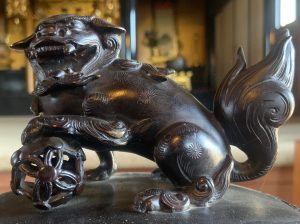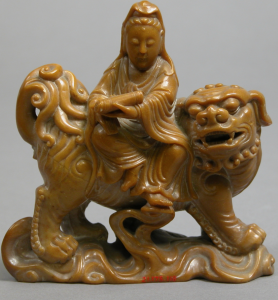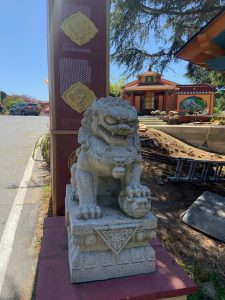
Look closely in your temple’s altar and you may spot various creatures lurking about, like strange, mythical birds and animals. Sitting atop an incense burner may be a lion dog.
This animal has an interesting background. Many ornaments found in Jodo Shinshu temples come from Japan, which in turn, borrowed symbolism from China, a country with no indigenous lions but with little dogs, called Shih Tzu (狮子) (“little lion”). Historians speculate these dogs partly were used as models for lion dogs. Chinese artists, having never seen a real lion, heard about the wild creatures and imagined how they might look, and combined those features with an animal they knew.
Lions did live in India, the birthplace of Buddhism. Shakyamuni Buddha was sometimes referred to as “Lion of the Shakyas,” referring to his royal blood and clan, but also to the power of the Dharma, the Buddhist teachings.
According to the Pali sutra Anguttara Nikaya:
Now, monks, whatever animals hear the sound of the roaring lion, king of beasts, they are afraid: they fall to quaking and trembling. Those that dwell in holes seek them; water-dwellers make for the water; forest dwellers enter the forest; birds mount into the air…
People too, on hearing the teachings of the Buddha, fall to quaking and trembling, saying, we who thought ourselves permanent are after all impermanent, we who thought ourselves stable, are after all unstable, not to last. So it seems, we are impermanent, unstable, not to last, and encompassed within the Self.
There are other Buddhist references to lions. For example, sutras describe the bodhisattva Manjusri, who symbolizes wisdom, sitting on a lion.

In Asia, statues of lion dogs sit at entrances to palaces and temples, representing guardians. Usually they’re found in pairs, one with mouth open and the other with mouth closed. Those dual expressions symbolize the dual sounds “Ah” and “Oh,” making the sound “Om” or “Aum,” which in Indian philosophy represents the sound of the universe.

Lion dogs in Japan are called komainu (狛犬)(Korea dog) which probably refers to its origin coming from China via Korea. The creature atop the incense burner at our temple in Berkeley, California, rests its paw on a ball, called cintamani , a precious jewel representing dharma and the preciousness of the Buddhist teachings.
Rev. Haya Akegarasu (1877-1954), an influential Higashi Honganji Buddhist teacher wrote about the lion:
Roar of the lion! For two years he has been meditating in his den. Now resolute, he emerges into our corner of the wilderness. His eyes shine; they measure the distant sky. All people, all things, when they hear his roar, become very quiet. Before his stately presence, they cannot help kneeling.
–Shout of Buddha, Orchid Press, Chicago, 1977
I once heard a legend about how these lion dogs sometimes suffer from a particular disease that makes them sick. However, they will lay in a field where a certain herb grows, which naturally infuses their bodies and cures their illness. This is a metaphor for how the Buddha dharma works.
In all these ways, our temple’s lion dog represents a guardian of the Dharma, ultimate truth, and the Dharma itself.
Next time you visit your local temple, pay your respects to the lion dog. See also if you can spy other creatures residing there, such as peacocks and dragons.
-Rev. Ken Yamada, editor, Shinshu Center of America
Ah om
Altar symbols: Lion Dogs
狛犬komainu, lion-dog, pairs lion-like creatures guard entrance
Meaning: ward off evil spirits, come in pairs, mouth open and mouth closed, “aum,” similar to Niō, guardians human form,
Chinese origin, from Tang dynasty, lions of India, artists copied, used by King Ashoka,
Shishi 獅子
Fox at Shinto shrines
Shihtzu dogs combined with Indian lions
Stood in front of imperial palace in china and temples, pairs, one with ball, and other restraining a cub, transmission from China through Korea
Lion represents Shakya clan, symbol of royalty and leadership
Roar of lion represents emptiness, buddhadharma, call to awakening
Bodhisattva Manjursri, who represents wisdom, is sometimes portrayed as riding on a lion, which taming the mind.
Shih Tzu favored in imperial court in China. Little Lion.
“Now, monks, whatever animals hear the sound of the roaring lion, king of beasts, they are afraid: they fall to quaking and trembling. Those that dwell in holes seek them: water-dwellers make for the water: forest dwellers enter the forest: birds mount into the air…
People too, on hearing the teachings of the Buddha, they fall to quaking and trembling, saying, we who thought ourselves permanent are after all impermanent, we who thought ourselves stable, are after all unstable, not to last. So it seems, we are impermanent, unstable, not to last, and included within a Self.”
Akegarasu, “Roar of the lion! For two years, he has been meditating in his den. Now, resolute, he emerges into our corner of the wilderness. His eyes shine; they measure the distant sky. All people, all things, when they hear his roar, become very quiet. Before his stately presence, they cannot help kneeling.”
Shakyamuni, lion of the Shakya clan, lion’s roar

